Wall lamp or chandelier? Find out which is the best choice for your lighting design project based on the characteristics of the environment you are illuminating.
Choosing the right lighting is essential in any project, whether it is residential or contract.
In fact, light has a preponderant effect on the visual impact on an aesthetic level, the rooms’ functionality and the desired atmosphere. With adequate lighting, for example, it is possible to make even the darkest and most confined rooms appear wider and brighter.
Conversely, wrong choices could compromise the success of the entire project.
In particular, when it comes to identifying the lighting fixtures for a home, one of the dilemmas that arises is the choice between wall lamps or chandeliers (or suspensions more generally).
The right solution does not depend exclusively on mere considerations of an aesthetic nature, linked to the taste of the architect, interior designer, or client. There is, in fact, a whole series of other factors to consider in order not to make mistakes in terms of style or functionality.
The objective of this article is to provide all the elements necessary to establish how to choose home lighting correctly.
In particular, we will take a look at:
- Better a wall lamp or chandelier? The 4 factors to consider
- Where to place wall lamps and chandeliers
- How to choose home lighting
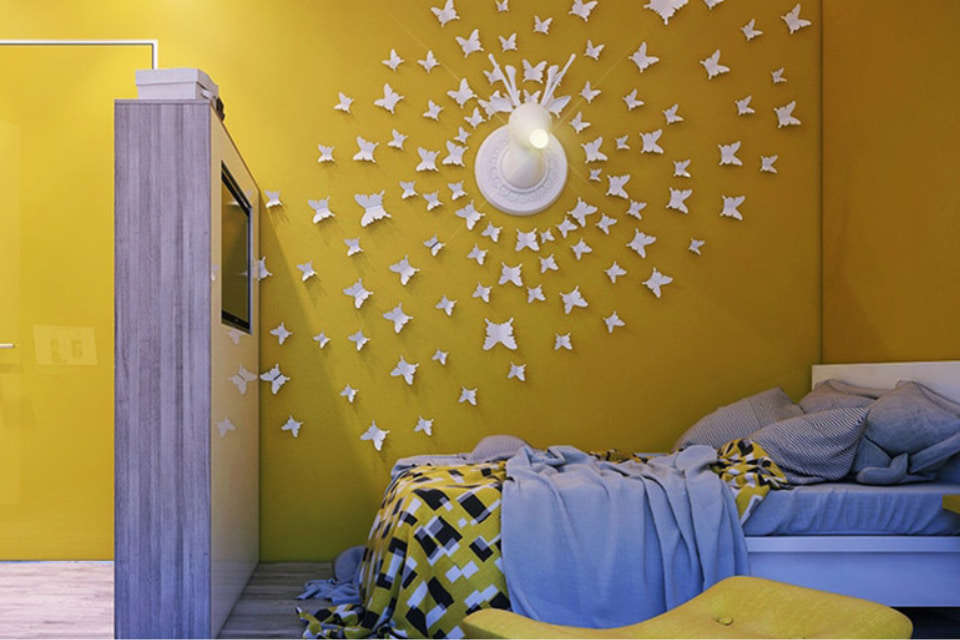
Marnìn
Better a wall lamp or chandelier? The 4 factors to consider
To answer the question "better a wall lamp or chandelier?", it is first necessary to understand the difference between the two types of lighting.
This consideration may be trivial, but it is essential for understanding which of the two solutions is more suitable for the lighting design project in question. It should also be noted that, often, one alternative does not exclude the other.
In fact, one or more suspension lamps and wall lamps can coexist successfully in the same room, for example, each fulfilling a specific function.
Regarding the differences, wall lamps are wall-mounted and small/medium, so they don’t take up space. However, their positioning must be established in the design phase, because their installation precludes the possibility of using furnishings at the same height on the same wall.
Alternatively, suspension lamps are installed on the ceiling both individually and in clusters.
Specifically, chandeliers are suspensions with large dimensions and a typical arm structure, each of which houses a light source. They offer a great scenic and decorative impact, but they take up space above you and fill the rooms.
To understand how to choose home lighting, let's look at the factors you should take into consideration.
1. The height of the ceiling and the size of the room
The height of the ceiling and the dimensions of the room you are illuminating are fundamental factors in a lighting project.
If you are dealing with a particularly small room, it is better to choose space-saving lamps, so you don’t risk making the room appear even smaller.
In these cases, therefore, wall lamps are the perfect solution to combine, according to taste and style, with recessed spotlights, ceiling lamps, or suspension lamps, as long as they are light and transparent.
Conversely, a large chandelier is the ideal choice to illuminate a room with a high ceiling, thanks to its ability to fill and enrich spaces.
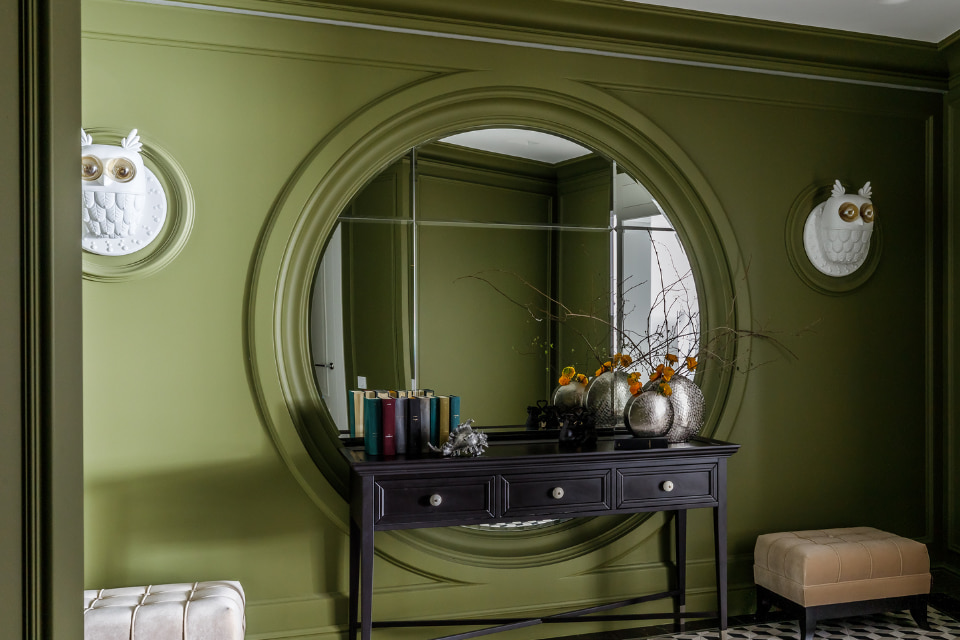
Ti Vedo
2. The function of the lighting in the room
There are 3 main lighting levels: using each one is critical to the success of any lighting design project.
First, you should consider the ambient lighting, i.e. the general lighting of the environment. It must be uniform, leave no shaded areas, and guarantee the right visual comfort.
Task lighting, on the other hand, illuminates a specific area. It must be precise and direct, to ensure an adequate level of functional light in areas where various activities take place.
Lastly, accent lighting serves to emphasize architectural details and enhance elements and furnishing accessories.
Each of these levels requires the right lamps.
If you are choosing light installations for ambient lighting, recessed spotlights and chandeliers, capable of offering diffused lighting, are definitely preferable. As for the task lighting sources, however, the choice will also depend on the room in question.
For example, to illuminate a hob, it is better to use one or more suspensions, while to give the right task lighting to bedside tables you could opt for wall lights instead of the classic table lamp with a lampshade.
3. The style of furniture and the customer’s tastes
Matching the lighting with the furnishing style is a basic rule. If you make a mistake here, you will make the environment chaotic and unwelcoming or, conversely, flat and lacking in personality.
In this case, rather than deciding whether a wall light or a chandelier is better, it is necessary to focus your attention on the style you intend to give to the environment.
In the past, chandeliers were associated with a rather classic idea, but today the market offers a wide variety of choices in terms of style and materials. This change in the market has made suspensions adaptable to any context, even the most modern.
However, the difference between the two solutions must be considered. Wall lamps may be the best choice if you are dealing with an environment that is already "rich" in terms of furnishings and accessories. Chandeliers, on the other hand, will offer the ability to make an "empty" room fuller, warmer, and more welcoming.
Satisfying the personal tastes of your customer is still a fundamental element, but it is also important to remember the functional role of light: the wall lamps alone will probably not be enough.
If the customer does not like suspension lamps, one or more ceiling lamps or spotlights may be the right alternative.
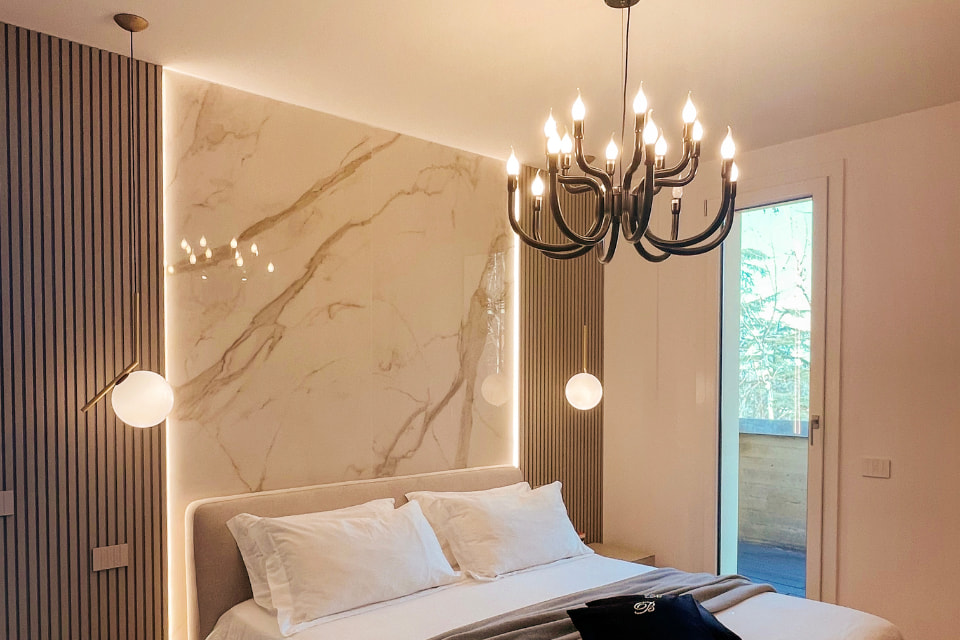
Snoob
4. The presence of natural light
In any lighting design, the goal should be to achieve the perfect integration between natural light and artificial light.
Therefore, the first step is to evaluate the possible presence of natural light sources such as windows, skylights, or patio doors. Depending on the presence or absence of these sources, the room will have different lighting requirements.
A dark or, worse, blind room will need artificial light for many more hours a day than one well lit by sunlight.
In these cases, illuminating the entire room with wall lamps could be a gamble. In fact, they guarantee less uniform and diffused lighting than chandeliers.
Where to place wall lamps and chandeliers
We have seen the differences between wall lamps and chandeliers and examined the factors to consider when choosing. It is necessary to reiterate an important concept – often, it is not an exclusive choice, and it is possible to insert both wall lamps and chandeliers into your lighting project.
The design of a living area, for example, could include the presence of recessed spotlights for general lighting and a chandelier for the task light on the dining table. Furthermore, one or more wall lamps may be needed to bring attention to a stone wall or design object.
Having made this premise, let us now move on to providing some suggestions for placing them in the best possible way.
Where to put the wall lamps
Before we talk about where you can put them, it is essential to determine the right height to place the wall lamps.
First, wall lamps should never be installed at eye level because they would be a visual disturbance.
The general rule is that they are installed above eye level, i.e. above 150\180 cm. However, taking into account an average ceiling height of 270 cm and that of 210 cm for the doors, the ideal height for wall lamps is between 190 and 220 cm.
In the case of higher or lower ceilings and doors, the calculation will have to be done for the specific case.
That said, wall lamps can be placed:
- On the walls bordering the corridors and other passageways;
- Above the bedside tables of the bedroom to provide task lighting for reading, for example, in this case, the height will obviously be different from the values seen above;
- On either side of the bathroom mirror, area requiring optimal levels of functional light;
- Above or below a picture or decorative element, to create a beam of direct light for accent lighting.
Of course, these are just examples. In fact, wall lamps can be used in any room.
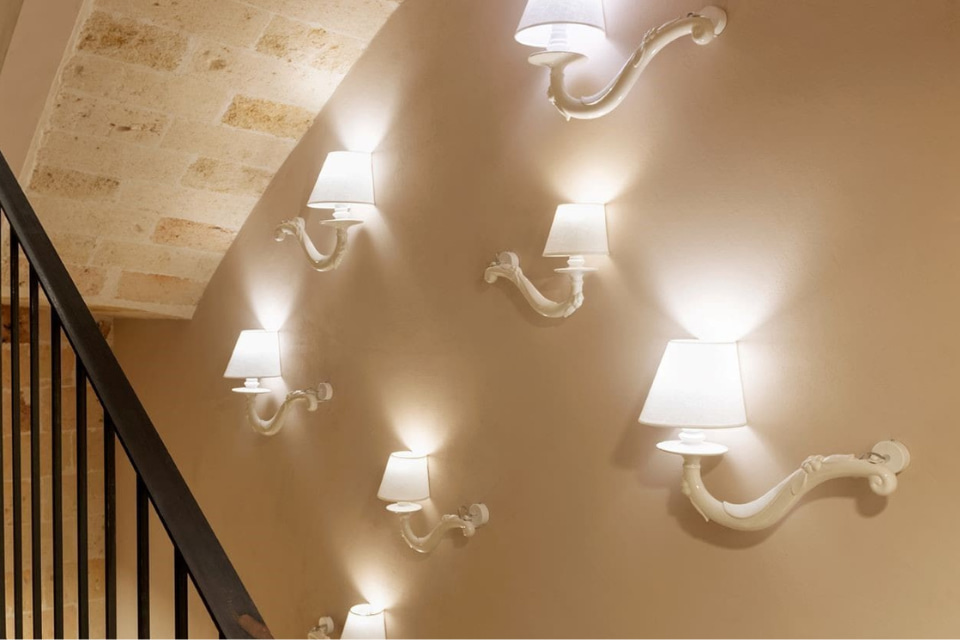
Déjà-Vu
Where to put a chandelier
Suspensions and chandeliers are evergreens, extremely versatile for any type of environment and style.
Transparent, brilliant, with a minimal or more elaborate style. Glass, ceramic, metal, or fiberglass. With classic shapes or a bold design, suspension lamps have the extraordinary ability to furnish as well as illuminate.
Most chandeliers should be placed at a height of about 2.10 meters from the floor: they must not be installed too low (at risk of impact) or so high as to appear suspended in space.
Below, let's take a look at some of the possibilities to include them in a lighting design project, both single and as clusters.
- In the center of the ceiling of each room (including the bathroom) for general lighting. A beautiful chandelier will itself be a furnishing element with a great aesthetic impact;
- To light up the dining table, guaranteeing the right visibility for the diners, positioning it at least 60 cm from the table top;
- In the kitchen, above the hob;
- To illuminate an internal staircase, if the ceiling height allows it. In this case, it is a good idea to opt for one or more suspensions based on the length of the staircase in question.
Always remember that the exact placement of the chandelier can vary according to the client's personal preference and the style they intend to give to the room.
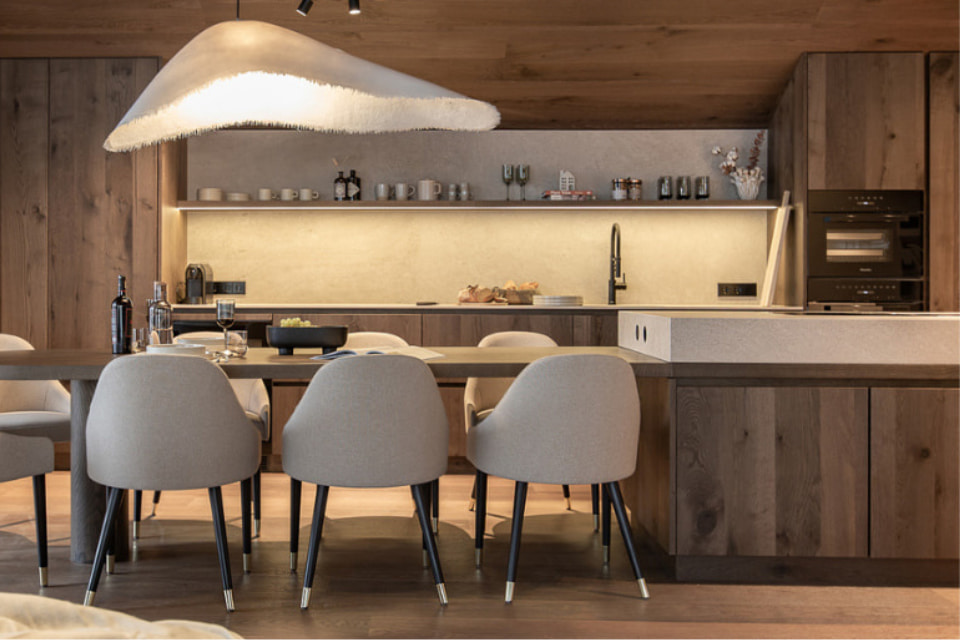
Moby Dick
Better a wall lamp or chandelier in the bedroom?
Illuminating the bedroom requires finding the right balance to create a relaxing and functional environment.
This room of the house, in addition to rest and relaxation, must also guarantee an adequate level of visibility, to carry out various activities such as getting dressed and getting ready.
Even in this environment, the ideal project can include more than just one lighting fixture to satisfy the three levels of lighting that we analyzed previously.
So, is it better to choose a wall lamp or chandelier to illuminate the bedroom in the best way?
There are various possibilities:
- Place a chandelier in the center of the room for general lighting and opt for two wall lights to illuminate the bedside tables;
- Use LED strips and spotlights instead of the chandelier and the wall lights as a source of task light;
- Opt for a chandelier and some table lamps for the bedside tables;
- Choosing ceiling lamps and spotlights for ambient lighting and suspension lamps that descend over the bedside tables;
- Choose wall lamps in the case of particularly small rooms as they are placed directly on the walls without taking up space.
As always, the choice will depend, in addition to the amount of lumens needed to adequately illuminate the environment, on the client's preferences and the desired mood.
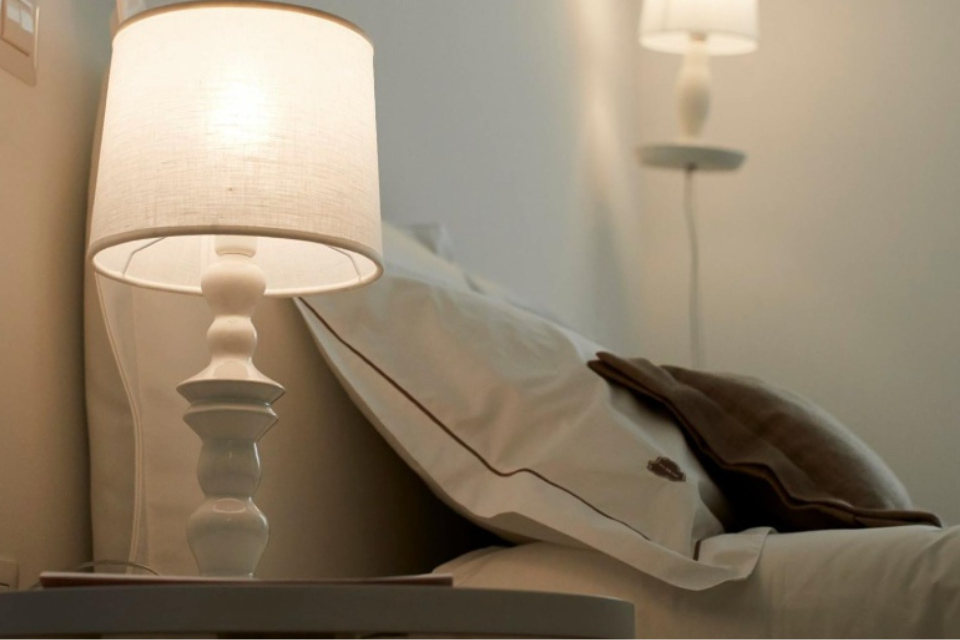
Alì e Babà
How to choose home lighting
To answer the question"better a wall lamp or chandelier?", we have found that it is necessary to take into consideration a plurality of factors.
The dimensions of the room in question, the height of the ceiling, the presence or absence of natural light, the furnishing style, and the customer’s tastes are all essential elements for the realization of the project.
Whether it's wall lamps or suspension lamps, today the market provides modern designer lamps capable of satisfying every type of style and taste.
The skill of the professional lies in knowing how to choose and combine the lamps to create combinations that are balanced and original. They must adapt to the furnishing style and mood of the location, without neglecting the functional role of lighting.
A well-structured lighting design project, as we have seen, should include layered lighting, where the three levels (ambient, task, and accent lighting) are perfectly in harmony.
So, ultimately, there is no absolute winner between wall lamps and chandeliers. What is needed is a wise use of each one, based on the specific role it will play.
If you would like support or assistance in choosing wall lamps and chandeliers for your lighting design project, please do not hesitate to contact us at this link. We are at your complete disposal.




